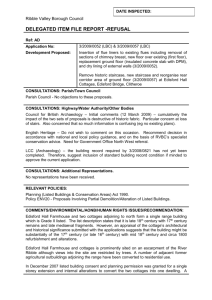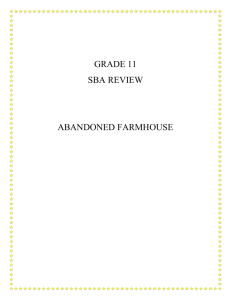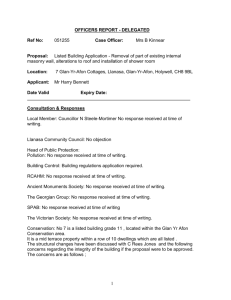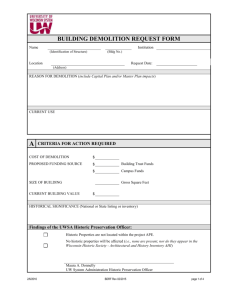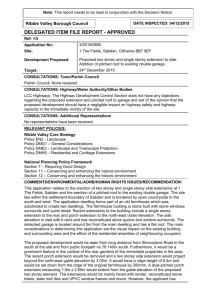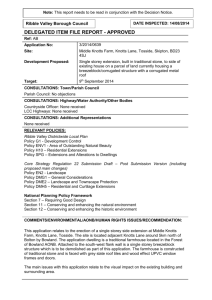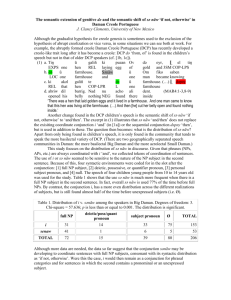ZDELR-0231 - Ribble Valley Borough Council
advertisement
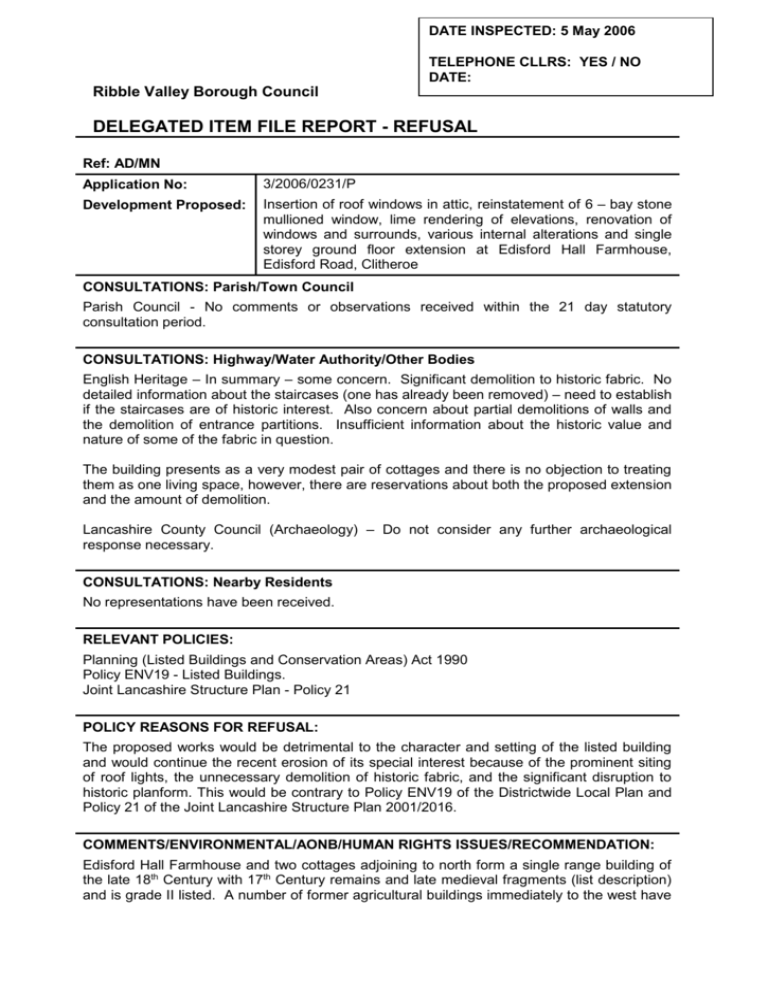
DATE INSPECTED: 5 May 2006 TELEPHONE CLLRS: YES / NO DATE: Ribble Valley Borough Council DELEGATED ITEM FILE REPORT - REFUSAL Ref: AD/MN Application No: 3/2006/0231/P Development Proposed: Insertion of roof windows in attic, reinstatement of 6 – bay stone mullioned window, lime rendering of elevations, renovation of windows and surrounds, various internal alterations and single storey ground floor extension at Edisford Hall Farmhouse, Edisford Road, Clitheroe CONSULTATIONS: Parish/Town Council Parish Council - No comments or observations received within the 21 day statutory consultation period. CONSULTATIONS: Highway/Water Authority/Other Bodies English Heritage – In summary – some concern. Significant demolition to historic fabric. No detailed information about the staircases (one has already been removed) – need to establish if the staircases are of historic interest. Also concern about partial demolitions of walls and the demolition of entrance partitions. Insufficient information about the historic value and nature of some of the fabric in question. The building presents as a very modest pair of cottages and there is no objection to treating them as one living space, however, there are reservations about both the proposed extension and the amount of demolition. Lancashire County Council (Archaeology) – Do not consider any further archaeological response necessary. CONSULTATIONS: Nearby Residents No representations have been received. RELEVANT POLICIES: Planning (Listed Buildings and Conservation Areas) Act 1990 Policy ENV19 - Listed Buildings. Joint Lancashire Structure Plan - Policy 21 POLICY REASONS FOR REFUSAL: The proposed works would be detrimental to the character and setting of the listed building and would continue the recent erosion of its special interest because of the prominent siting of roof lights, the unnecessary demolition of historic fabric, and the significant disruption to historic planform. This would be contrary to Policy ENV19 of the Districtwide Local Plan and Policy 21 of the Joint Lancashire Structure Plan 2001/2016. COMMENTS/ENVIRONMENTAL/AONB/HUMAN RIGHTS ISSUES/RECOMMENDATION: Edisford Hall Farmhouse and two cottages adjoining to north form a single range building of the late 18th Century with 17th Century remains and late medieval fragments (list description) and is grade II listed. A number of former agricultural buildings immediately to the west have been converted to residential use. In 1984 listed building consent (84/588) was granted for the demolition of existing lean-to and erection of kitchen extension and porch, and internal alterations and improvements at the farmhouse. In 1995 listed building consent (95/447) was granted for the removal of cement render from the elevations of the farmhouse. In 2002 listed building consent (02/389) was granted for the re-roofing of the east facing roof slope to all three of the dwellings (stone slate to Welsh blue). In 2002 listed building consent (02/635) was granted for proposed alterations to existing farmhouse front elevation windows (removal of windows with plain stone surrounds and square mullions mentioned in list description and replacement with 17th Century styled windows). On my site inspection of 5 May 2006 it was noted that render had been removed from two extensive areas of cottage walling at front (east) and rear elevations. However, this has revealed the nature of historic wall facing – a lime roughcast render covering random rubble. The whole of the front wall of the farmhouse appears to have recently been demolished and rebuilt (blockwork backing to a stone face) in stonework which does not match (ie squared and coursed rubble) that exposed at the adjoining cottages. This wall incorporates new window openings which do not correspond to historic photos or the list description in dimensions or position. The medieval fragments (eg reset stones with decorative motifs) referred to in the list description have also been repositioned in the new build. The four light 17th Century window mentioned in the list description and referred to in the 02/635 officer report as the “only one good example.. to be retained and repaired” has been removed and replaced with a modern window. The front elevation porch which received permission by 84/588 has been demolished and recently replaced with a much larger and conspicuous porch. The chimney between farmhouse and cottage has been removed. farmhouse has been removed and replaced with a modern version. The chimney at the At the rear elevation of the farmhouse French windows have been installed, a historic window opening has been remodelled and three roof lights have been installed close to roof ridge. It is intended that a thorough inspection of the property be arranged, particularly with regard to the current state of the rare timber mullioned window (less than 10 remaining examples in the County?) at the first floor of the front wall at the junction of the farmhouse and cottages.This was identified on the plans of 84/588 and found to be externally exposed on a previous site inspection of 5 February 2003. I am mindful of the above unauthorised and detrimental work, previously approved works, and the warning in paragraph 3.13 of PPG15 and believe any further works to the listed building will now have to be very carefully considered. Notwithstanding this I believe the works now proposed would be detrimental inter alia. The west roof slope is prominent and would be an inappropriate location for three roof lights. The part blocked 17th Century window on the west elevation would now appear to be the last survival of its type in the building and to have been part blocked for a considerable period of time (eg blocking in lime mortar) – mindful of paragraph C.6 of PPG15 and noting that little justification for the works has been presented, I consider this element of the works to be inappropriate. In my opinion, and following my site inspection of the inside of the cottages on 7 November 2005 it would appear that the cottages could be older than the late 18th Century date ascribed in the list description. Splayed window reveals, the single room depth and cellular nature of the spaces contained by the external walls with centred original chimney stacks , and some deeply splayed chamfered and stopped beams suggest 17th Century origins. The internal plan form may be contemporary with the cottage façade and appears to represent a distinct and interesting layer of history. I would, therefore, agree with English Heritage that the level of demolition (one stair flight has already been removed) and resultant change of plan form would appear unjustified. I am mindful of English Heritage’s concern with the proposed extension to the “.. very modest pair of cottages”. In my opinion, the provision of two new openings in the gable wall would appear unnecessary. The plans would appear to suggest replacement of the existing historic sash windows (no “horns” – pre 1840?) and doors at the front elevation without justification or comment upon the opportunity for repair. RECOMMENDATION: That listed building consent be refused.


